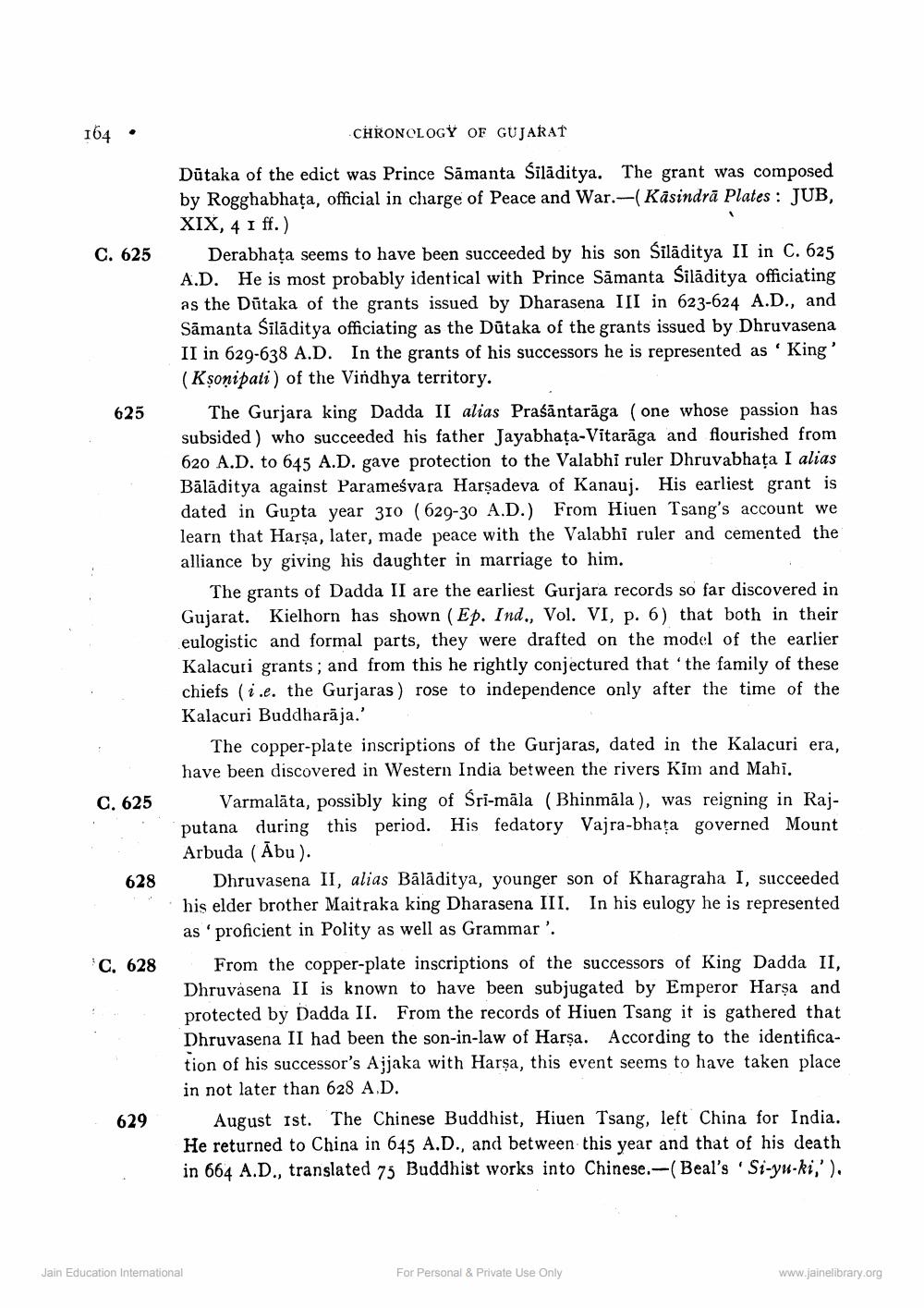________________
164 •
CHRONOLOGY OF GUJARAT
C. 625
625
Dūtaka of the edict was Prince Sāmanta Šilāditya. The grant was composed by Rogghabhața, official in charge of Peace and War.-( Käsindrā Plates : JUB, XIX, 4 1 ff.)
Derabhața seems to have been succeeded by his son Silāditya II in C. 625 A.D. He is most probably identical with Prince Samanta Silāditya officiating as the Dūtaka of the grants issued by Dharasena III in 623-624 A.D., and Samanta Silāditya officiating as the Dütaka of the grants issued by Dhruvasena II in 629-638 A.D. In the grants of his successors he is represented as 'King' (Ksonipati) of the Vindhya territory.
The Gurjara king Dadda II alias Praśāntarāga (one whose passion has subsided) who succeeded his father Jayabhața-Vitarāga and flourished from 620 A.D. to 645 A.D. gave protection to the Valabhi ruler Dhruvabhata I alias Bālāditya against Parameśyara Harşadeva of Kanauj. His earliest grant is dated in Gupta year 310 (629-30 A.D.) From Hiuen Tsang's account we learn that Harsa, later, made peace with the Valabhi ruler and cemented the alliance by giving his daughter in marriage to him.
The grants of Dadda II are the earliest Gurjara records so far discovered in Gujarat. Kielhorn has shown (Ep. Ind., Vol. VI, p. 6) that both in their eulogistic and formal parts, they were drafted on the model of the earlier Kalacuri grants; and from this he rightly conjectured that the family of these chiefs (i.e. the Gurjaras) rose to independence only after the time of the Kalacuri Buddharāja.'
The copper-plate inscriptions of the Gurjaras, dated in the Kalacuri era, have been discovered in Western India between the rivers Kim and Mahi.
Varmalāta, possibly king of Sri-māla (Bhinmāla), was reigning in Rajputana during this period. His fedatory Vajra-bhata governed Mount Arbuda (Abu).
Dhruvasena II, alias Bālāditya, younger son of Kharagraha I, succeeded his elder brother Maitraka king Dharasena III. In his eulogy he is represented as 'proficient in Polity as well as Grammar'.
From the copper-plate inscriptions of the successors of King Dadda II, Dhruvasena II is known to have been subjugated by Emperor Harsa and protected by Dadda II. From the records of Hiuen Tsang it is gathered that Dhruvasena II had been the son-in-law of Harșa. According to the identification of his successor's Ajjaka with Harsa, this event seems to have taken place in not later than 628 A.D.
August 1st. The Chinese Buddhist, Hiuen Tsang, left China for India. He returned to China in 645 A.D., and between this year and that of his death in 664 A.D., translated 75 Buddhist works into Chinese.-(Beal's 'Si-yu-ki,').
C. 625
628
C. 628
629
Jain Education Interational
For Personal & Private Use Only
www.jainelibrary.org




